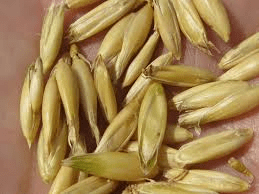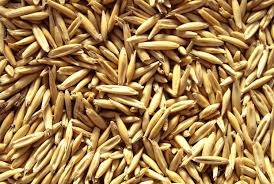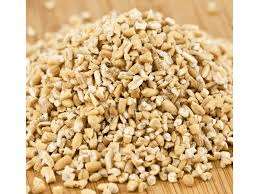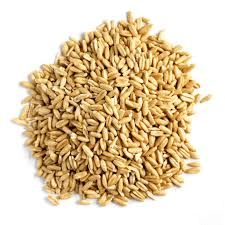Oat kernels, often referred to as oat groats, are the whole, unprocessed seeds of the oat plant (Avena sativa). These kernels are the most intact and unrefined form of oats available, maintaining all parts of the grain, including the bran, germ, and endosperm. Oat kernels are celebrated for their dense nutritional profile and versatility in various culinary applications.
The oat kernel comprises several layers, each with its unique nutritional attributes. The outermost layer, known as the bran, is rich in dietary fiber, particularly soluble fiber called beta-glucan. This fiber is notable for its ability to lower cholesterol levels by forming a gel-like substance in the digestive tract, which binds to cholesterol-rich bile acids and removes them from the body. This action helps reduce total and LDL (bad) cholesterol, promoting heart health. The bran also contains a variety of vitamins, such as B vitamins, and minerals, including iron and magnesium.
Beneath the bran lies the germ, the nutrient-rich core of the oat kernel. The germ contains healthy fats, proteins, vitamins, and antioxidants. It is particularly high in vitamin E and B vitamins, which support metabolic and immune functions. The germ’s healthy fats, including unsaturated fats and essential fatty acids, contribute to heart health and provide sustained energy.
The endosperm, the largest part of the oat kernel, is packed with carbohydrates and proteins, serving as the primary energy source for the growing plant. The carbohydrates in the endosperm provide a slow, steady release of energy, making oat kernels a beneficial food for sustained energy levels and blood sugar control. The proteins in the endosperm are of high quality, containing a good balance of essential amino acids.
Oat kernels are incredibly versatile in the kitchen. Due to their unprocessed nature, they have a chewy texture and nutty flavor, making them a hearty and satisfying addition to various dishes. To prepare oat kernels, they typically need to be cooked for a longer period than more processed oat products, such as rolled or instant oats. Cooking oat kernels can take between 30 to 45 minutes, but soaking them overnight can significantly reduce the cooking time.
One common use of oat kernels is as a breakfast cereal. They can be cooked and served like oatmeal, providing a nutritious and filling start to the day. Additionally, oat kernels can be used in savory dishes as a substitute for rice or other grains. They can be added to soups, stews, casseroles, and salads, offering a nutritious and texturally interesting component.
Oat kernels can also be ground into oat flour, which is used in baking to make bread, muffins, and other baked goods. Oat flour is naturally gluten-free, making it a suitable option for those with gluten sensitivities or celiac disease, provided it is processed in a gluten-free environment.
In the beverage industry, oat kernels are used to produce oat milk, a popular plant-based milk alternative. Oat milk is made by blending soaked oat kernels with water and then straining the mixture to remove the solids. The result is a creamy, nutritious beverage that can be used in coffee, smoothies, cooking, and baking.
In agriculture, oat kernels are used as animal feed, providing essential nutrients to livestock, particularly horses. Their high nutritional content supports the health and growth of animals.
In summary, oat kernels are the whole, unprocessed form of oats that retain all parts of the grain, including the bran, germ, and endosperm. They are rich in dietary fibre, protein, vitamins, and minerals, offering numerous health benefits, including improved heart health and sustained energy levels. Their versatility in cooking and use in various products, such as oat flour and oat milk, make oat kernels a valuable and nutritious component of a healthy diet.
The Economic Importance and Uses of Oat Kernels

1. Human Consumption: Oat kernels are primarily consumed as a nutritious whole grain, cooked similarly to rice or used in dishes like pilafs and salads.
2. Breakfast Cereals: Oat kernels are processed into various types of breakfast cereals, including rolled oats and quick oats, providing a hearty and healthy breakfast option.
3. Baking: Oat kernels are ground into oat flour, which is used in baking bread, cookies, muffins, and other baked goods, enhancing texture and nutritional value.
4. Porridge: Oat kernels are boiled or soaked to make oatmeal porridge, a popular and nutritious breakfast dish.
5. Snack Foods: Roasted oat kernels are used in snack mixes, granola bars, and energy bars for their crunchy texture and nutritional benefits.
6. Animal Feed: Oat kernels are a valuable component of animal feed for livestock and poultry, providing essential nutrients and promoting digestive health.
7. Brewing Industry: Oat kernels are used in brewing beer, contributing to flavor, texture, and nutritional content.
8. Culinary Uses: Oat kernels are used in various culinary applications, such as soups, stews, and stuffing, adding texture and nutritional value to dishes.
9. Infant Food: Ground oat kernels are used in infant cereals and baby food for their mild flavor and digestibility.
10. Pet Food: Oat kernels are included in pet food formulations for their nutritional benefits and digestibility.
11. Dietary Supplements: Oat kernel extracts are used in dietary supplements for their fiber content and health-promoting properties.
12. Cosmetic Industry: Oat kernel extracts are used in skincare products for their soothing and moisturizing properties, suitable for sensitive skin.
13. Pharmaceutical Industry: Oat kernel derivatives are used in pharmaceutical formulations for their therapeutic effects, such as cholesterol management and digestive health.
14. Biofuel Production: Oat kernels and their by-products can be used in biofuel production, contributing to renewable energy sources.
15. Environmental Remediation: Oat kernels can be used in environmental remediation projects to absorb pollutants from soil and water.
16. Paper Industry: Oat kernel fibers are used in the paper industry to produce specialty papers and packaging materials.
17. Textile Industry: Oat kernel fibers are used in the textile industry for producing sustainable fabrics and materials.
18. Horticulture: Oat kernels are used in horticulture as mulch or soil amendment to improve soil structure and moisture retention.
Read Also: 14 Medicinal Health Benefits of Ghost Pepper (Capsicum Chinese)
The Products and By-products That Can Be Derived From Oat Kernels

1. Rolled Oats: Oat kernels are steamed and flattened to produce rolled oats, commonly used in oatmeal and baking.
2. Quick Oats: Oat kernels are pre-cooked and rolled thinner than traditional rolled oats, reducing cooking time for convenience.
3. Oat Flour: Oat kernels are ground into flour, used in baking to add fiber and nutritional value to bread, cookies, and other baked goods.
4. Oat Bran: The outer layer of oat kernels is processed into oat bran, used as a dietary fiber supplement in food products.
5. Oat Milk: Oat kernels are blended with water and strained to produce oat milk, a dairy-free alternative.
6. Oat Oil: Oat kernels are pressed to extract oat oil, used in cosmetics and personal care products.
7. Oat Bran Cereal: Oat kernels are processed into oat bran cereal, providing a nutritious breakfast option rich in fiber.
8. Oat Protein: Oat kernels are processed to extract oat protein, used in protein supplements and food products.
9. Instant Oats: Oat kernels are pre-cooked and dried to produce instant oats, which cook quickly.
10. Granola: Oat kernels are mixed with honey, nuts, and dried fruits to make granola, a popular snack.
11. Oat-Based Snack Bars: Oat kernels are used in the production of snack bars, providing a convenient and nutritious snack option.
12. Oatmeal Cookies: Oat kernels are used in cookie recipes to create chewy oatmeal cookies with added texture and nutrition.
13. Oat Flour Pancakes: Oat kernels are ground into flour and used in pancake mixes for a wholesome breakfast option.
14. Oat Bread: Oat kernels are added to bread recipes to create whole-grain loaves with added fiber and nutrients.
15. Oat-Based Cosmetics: Oat kernels and extracts are used in skincare products for their soothing and moisturizing properties.
16. Oat-Based Pharmaceuticals: Oat kernel derivatives are used in pharmaceutical formulations for their health benefits, particularly in managing cholesterol levels and promoting overall wellness.
17. Oat-Based Animal Feed: Oat kernels are included in animal feed formulations for their nutritional benefits and digestibility.
Read Also: How often you need to Change Water in your Fish Farm
Frequently Asked Questions (FAQ’s) About Oat Kernels

1. What are oat kernels?
Oat kernels are the whole grains of oats, containing the bran, germ, and endosperm.
2. How are oat kernels used in cooking?
Oat kernels are used to make oatmeal porridge, rolled oats, quick oats, and in various baked goods like bread, cookies, and muffins.
3. Are oat kernels gluten-free?
Pure oat kernels are naturally gluten-free, but cross-contamination can occur during processing, so certified gluten-free sources should be sought for those with gluten sensitivity.
4. What are the health benefits of oat kernels?
Oat kernels are rich in fiber, vitamins, and minerals, known for their cholesterol-lowering effects, digestive health benefits, and role in weight management.
5. Can oat kernels be used in skincare products?
Yes, oat kernels and extracts are used in skincare products for their soothing and moisturizing properties, suitable for sensitive skin.
6. How are oat kernels beneficial in animal nutrition?
Oat kernels are used in animal feed for their nutritional benefits, providing essential nutrients and supporting digestive health in livestock and poultry.
7. What environmental benefits are associated with oat kernels?
Oat kernels contribute to sustainable practices through their use in biodegradable packaging, biofuel production, and soil remediation, reducing environmental impact.
8. Are there any industrial applications for oat kernels?
Oat kernel fibers are used in the paper and textile industries to produce eco-friendly products and materials, supporting sustainable manufacturing practices.
9. How does oat kernels contribute to biofuel production?
Oat kernels and their by-products can be fermented to produce bioethanol, contributing to renewable energy sources and reducing dependence on fossil fuels.
10. Can oat kernels be used in pharmaceutical products?
Yes, oat kernel derivatives are used in pharmaceutical formulations for their health benefits, particularly in managing cholesterol levels and promoting overall wellness.

